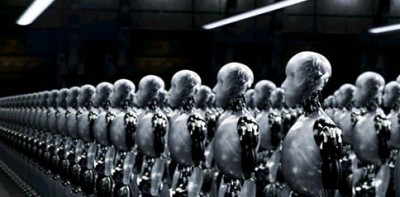Robots Will Cut 25% of US Jobs in 4 years, Transform Workforce

The encroachment of self-help kiosks and grocery store scanners has led doomsayers to suggest automation threatens the workforce of the future. A new report argues it will create new business sectors and new jobs as well.
By studying large companies in various industries, from Delta Airlines Inc. to Whole Foods Market Inc., as well as many startups, analysts have forecast that automation will erase 22.7 million jobs by 2025, or 16 percent of today’s total.
The prediction comes in a report titled “The Future of Jobs, 2025: Working Side-By-Side with Robots,” published by Forrester Research this week. The study’s findings were drawn from government employment data, and interviews with businesses and academics.
Automation in daily life is already prevalent and expanding beyond the grocery store scanner. Robots are now delivering room service to guests in the Aloft hotel in San Francisco, and self-service kiosks filling orders at delis rather than humans.
Lowe’s hardware is testing Oshbot, a robotic sales assistant that can answer questions, and show customers a floorplan of the store or lead them directly to products they seek. It was recently featured in an RT segment.
However, the study argued that the decline in service jobs caused by increasing automation would be offset by the creation of new ones, reducing net jobs losses to only 9.1 million, or 7 percent.
“Physical robots require repair and maintenance professionals – one of several job categories that will grow up around a more automated world,” wrote J P Gownder, the lead author in Forbes.
“That’s a net loss of 7 percent: far fewer than most forecasts, though still a significant job loss number.”
Robots are defined in the study as physical robots that do manual labor on assembly lines or in warehouses. Included in the definition is sophisticated software capable of crunching large amounts of data to perform intellectual tasks such as giving medical diagnoses, analyzing the weather, or coming up with culinary recipes.
Automation will and is replacing the work of people, but the report argued for every 10 jobs automated, one new job will be created in software engineering, design, maintenance, and support or training.
Gownder’ team said by 2019, 25 percent of all job-based tasks will have been offloaded to software robots, physical robots, or customer self-service automation.
The most job losses will occur in sectors like office support, construction, and sales, with self-help services replacing cashiers, retail salespeople, and real estate brokers and agents.
The report also found smart household gadgets would threaten the livelihoods of repair workers, plumbers and electricians.
“These are not white-collar jobs,” J P Gownder told WIRED. “This is the evolution of the repair person. It’s harder to fix a robot than to fix a vending machine.”
The report found for most workers, robotic challenges would change the way people approached their daily jobs, requiring new methods of job training, management, and financial reporting systems.
Gownder’s report presents a less dire view to the one presented in the often-quoted Oxford University study of 2013 “The Future of Employment: How Susceptible Are Jobs to Computerisation” from academics Carl Frey and Michael Osborne. Their analysis predicted robots will displace jobs at an alarming rate, finding that 47 percent of total US jobs were “at risk” of being replaced by automation.

